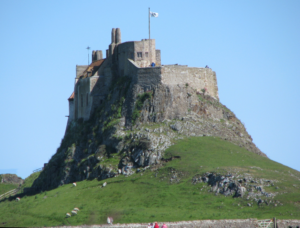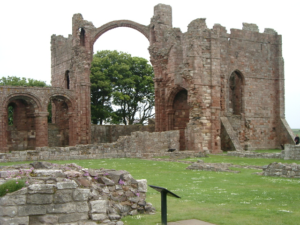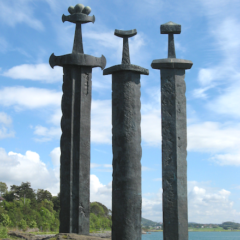Off the north east coast of England, the sails of some dragon boats suddenly appeared on 8.6.793. The monastic monks of Lindisfarne, if they had even noticed the approaching ships at all, were hardly worried; rather curious maybe. Pilgrims and merchants had in any case frequently come to the small harbour of Lindisfarne. But this time everything was very different! Nordic pirates landed and immediately began to attack and kill. The surprised and defenceless monks and the few other inhabitants of this lonely island had no chance: they were slaughtered or abducted as slaves. The precious chalices, reliquaries, mass goblets and robes, livestock and supplies were taken. In a short time, the nightmare was over, and only smoking debris was left behind.
The report of this Viking raid, still remembered today and reported at the time in the Anglo-Saxon chronicles reads in modern English:
„A. D. 793: This year came dreadful fore-warnings over the land of the Northumbrians, terrifying the people most woefully: these were immense sheets of light rushing through the air, and whirlwinds, and fiery dragons flying across the firmament.
These tremendous tokens were soon followed by a great famine: and not long after, on the sixth day before the ides of January in the same year, the harrowing inroads of heathen men made lamentable havoc in the church of God in Holy-island, by rapine and slaughter.“
The importance of the attack on Lindisfarne in June 793 was not so outstanding as it is represented in today’s historiography and was certainly not the first Viking raid along British coasts. In fact from 617 to 840 AD there were dozens of raids along the coasts of Central Europe. The exaggerated attention to these particular events of the summer of 793 was due to two reasons:
1. Lindisfarne Abbey was the outstanding ecclesiastical institution of the then Kingdom
of Northumbria.
2. News of the raid quickly spread horror and panic throughout the region. As a result,
the spread of Christianity accelerated and there was the welcome side effect that the
aristocrats rushed to refurbish the monastery which meant that the Abbey retained its
former splendour.
Lindisfarne Castle <-> Lindisfarne Abbey
One of the consequences of our world of short, rushed lives is that even in articles found in the serious press, the two places mentioned above are can often be confused. A few sentences are hastily typed, then some picture hastily downloaded from the Internet….. and it’s already the wrong one! Castle and Abbey – war and peace, as I wrote in my book.
So here is the true account of each:
Lindisfarne Castle, built in 1548/9
Lindisfarne Castle is located on an ancient extinct volcano, called „Beblowe Hill“ or „Beblowe Craig“. The fort was built during the wars of King Henry VIII against the Scots. In 1543, more than 2000 soldiers landed on the Holy Island of Lindisfarne to defend England. The medieval monastery ruins were used by the army as stables and warehouses. In an effort to defend the island, it was decided to build a small fort armed with two canons on Beblowe Hill, two kilometres away. The ruins of the Abbey served to supply building materials, as was customary at that time. Later centuries saw the small fort being rearmed again and again, but never with more than five modest cannons and a detachment of 25 men – there was no room for anymore.
At the beginning of the 20th century, the now dilapidated fort was bought by a private individual and converted into a „weekend house“. Today it belongs to the National Trust and is open to the public.
Lindisfarne Castle has nothing to do with the Viking raid of summer 793!

Lindisfarne Castle, Photo: U. Pape
Lindisfarne Abbey,
the Abbey on Holy Island of Lindisfarne, has quite definitely a different historical background altogether! It was founded in about 635 A. D. and was an important ecclesiastical centre for contemplation and science with influence all the way to the continent. This was due to one of the most important English saints, St. Cuthbert. Thus, the Lindisfarne monastery was by the 7th and 8th century already an important religeous location for that time, where, among other things, the scriptorium Christian texts and books were produced and copied, such as the well-known and famous manuscript „The Lindisfarne Gospels“.
The 8th June 793 was the scene of the Viking invasion the monastery of Lindisfarne, which has been chronicled many times and still resonates to this day. The attack is often referred to as the „first Viking raid on England“, but this is not true! Attacks had already occurred before, one, for instance, having been recorded in the Anglo-Saxon chronicles for the year 787 (Portland/Dorset) !
Despite the uncertain times, the Abbey at Lindisfarne survived the Viking raids until 875. In that year, the monks fled to the mainland for their own safety and for the safety of their relics, their saints and of their precious manuscripts. The buildings fell into disrepair and only in 1081, after the „Norman Conquest“, a new „Priory“ was built on Holy Island of Lindisfarne. It is the ruins of these and later buildings that we can visit today.
In 1537, as a result of the „Dissolution of the Monasteries“, the monastery of Lindisfarne also became a victim of Henry VIII’s harsh policy towards the Church. The monastery was abolished, the treasures of the monastery were appropriated into the king’s treasury and the buildings were left to decay or used for various purposes (providing building material or storage facility for the king’s army …).
The monastery buildings and extensions of 1081 and later, are all well documented, but no finds have been made of the original constructions from the 7th century, particularly on and around „Beblowe Craigh“. The extensive buildings were certainly located on a wide, level ground, due to their size. It is assumed that the old monastery and farm buildings were located on the same site as the present settlement around the monastery ruins.
Nor must we forget that the exact line of coast in the northeast of England in the 8th to 11th century is not known to any certainty.

Lindisfarne Abbey Ruins 11th Century (Photo: U. Pape)
